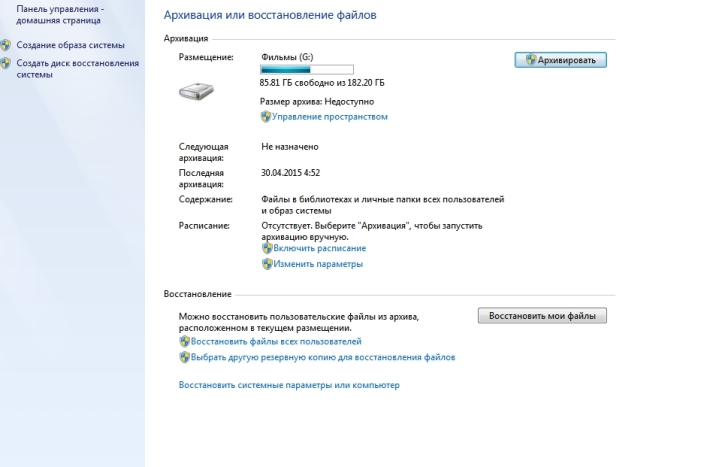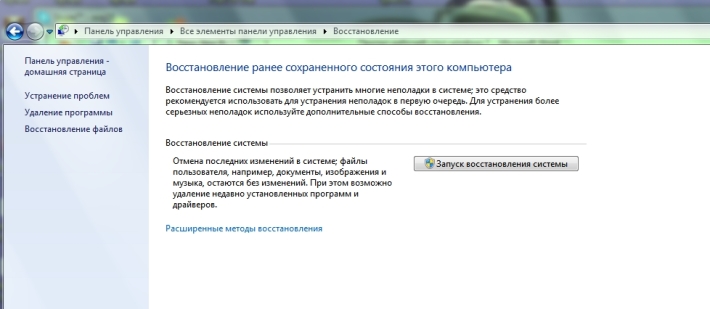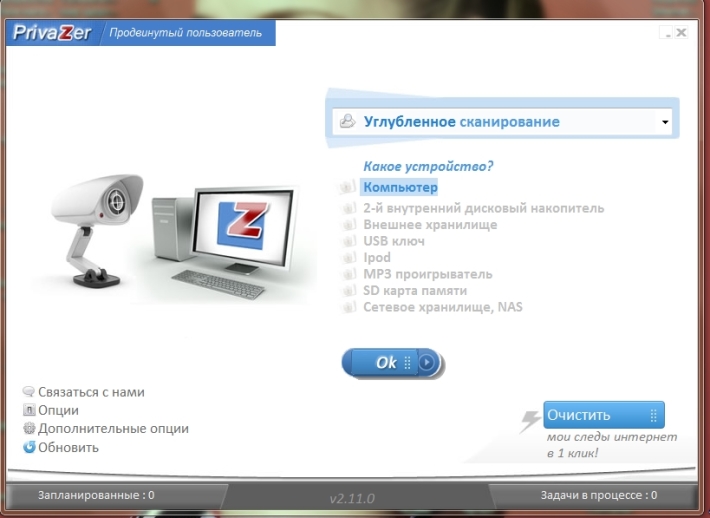You will not see any shortcuts that launch applications - only background picture. In general, the desktop is gone!
The easiest way to treat this malfunction is to roll back to a previous restore point. To do this, press Ctrl+Alt+Del. In the dispatcher that opens, select "New Task" from the "File" menu. In the drop-down menu, we type the path to the rstrui.exe file (restore wizard) located in the system directory C:\windows\system32\restore\. Upon completion of this simple operation, press the "OK" button.
A wizard appears where you will need to select the one you need (we select the date when everything was in order). We reboot. If the virus program belongs to the category of simple ones, then everything should work out. And the next time you reboot, you will see the old Gone is now a virus that cannot prevent the shell from loading.
But it happens that the malware blocked the launch of the task manager. This is not a problem either. It's just that when booting, after the POST procedure, you just need to press F8 and select from the many options, among which you can get lost, "Safe Mode" (with default boot) instead of a shell command line. After that, you need to type explorer. The shell should load. For now, that's enough. After we go to the "Run" menu and drive in the previous path to the system restore point wizard.
After the above operations, you should clean the system with any common antivirus with the latest signature databases.
The above method is applicable for the optimal scenario when you have restore points in your system. If the corresponding service was stopped immediately after installing the OS (as recommended in articles on optimizing Windows), then none of the above methods will suit you. The “desktop disappeared” problem is unsolvable for you in the previous way. But there is a way out of this situation. Let's look at a more complex algorithm.
This method will perfectly help to cope with the “desktop missing” problem. Vista, 7 are operating systems for which this method of solving the problem is perfectly suitable. Run the regedit command. We look for the presence of sections useinit.exe, explorer.exe, as well as the vital winlogon.exe file located in the following registry hive - HKEY_LOCAL_MACHINE, subsection SOFTWARE, then select Microsoft \ Windows NT \ CurrentVersion, select the next level - Image File Execution options. If sections are present, then safely delete them. We do the same with explorer.exe if it is present in the registry path HKEY_CURRENT_USER\Software\Microsoft\Windows NT\CurrentVersion\Devices.
Then we check the values of the following parameters, the correct definitions are indicated in brackets: Shell (explorer.exe), Userinit (logonui.exe), ULhost (C:\WINDOWS\system32\userinit.exe,) in this path - HKEY_LOCAL_MACHINE, subkey of the SOFTWARE registry hive . Then select Microsoft. Go to the Windows NT subdirectory. Well, in the CurrentVersion subsection, find Winlogon. We bring the keys to the correct state, and you can say goodbye to the “desktop missing” problem. Install a good antivirus. And to surf the web, use a more reliable browser ( Google Chrome or Mozilla Firefox).
If you often have to clean the system from the consequences of running a malicious software, it is best to use AVZ utility, which allows you to clean startup (select "Service", in the drop-down menu open "Startup Manager").
The fact that an unwanted program cannot interfere with autoload editing is guaranteed by the AVZGuard and AVZPM functions, which block the launch of untrusted applications while AVZ is working with the registry.
After completing the work, you can restore the registry keys modified by the virus using the standard procedure available in all operating systems starting with Windows XP - "System Restore" (located in the file menu, you can also get rid of the remnants of the "desktop missing" problem).
You can also use automated search and destruction of malware. Just put the "checkbox" "Perform treatment" (as an action, specify "Delete"). We select system folders on the disk, the check of which is critical ( system Windows, directories where malware can still hide - "Documents and Settings" and "Program Files").
On the "File types" tab, you can also choose which ones to scan (all or only potentially dangerous ones). In addition, you can set the heuristic level on the "Search Options" tab. After completing all the settings, click "Start". The duration of the scan depends on which heuristic level was selected, as well as how many files were selected as objects for cleaning.
Hints:
The desktop is gone: shortcuts and the taskbar with the Start menu do not appear.
Requirements.
To perform the steps in this article, you must have local administrator rights on the computer.
The article is applicable for Windows 2000/XP/ Vista/7
Information.
If the desktop did not appear when the computer was booted, i.e. instead of the usual shortcuts and the taskbar, only the background image is displayed on the screen, then most likely your computer has been attacked by viruses (unless, of course, you yourself have broken something).
Desktop recovery.
Attention!Before performing the steps in this article, check your computer for viruses, " this will be enough". Otherwise, you will correct errors, and after a reboot, the viruses will again do everything they need.
Method number 1.
Let's start with the simplest. You need to check the option that disables the display of icons on the desktop:
Windows 2000.
Desktop
ActiveDesktop";
Windows XP.
1. Click right click mice on the desktop;
2. In the menu that opens, select " Arrange icons";
3. In the expanded submenu, next to the item " Show desktop icons"There should be a checkmark. If there is no checkmark, then click on this item.
Windows Vista/7
1. Right click on the desktop;
2. In the menu that opens, select " View";
3. In the expanded submenu, next to the item " Show desktop icons"There should be a checkmark. If there is no checkmark, then click on this item.
Note.The result will not appear immediately, but with a delay of 3 - 10 seconds, it all depends on the performance of the computer and its "clutter".
Method number 2.
If method number 1 did not help, then we try to start the processexplorer.
exeby hand. One of its tasks is to display the desktop:
Ctrl" and "Alt ", and then click the " Delete ";
2. In the "Task Manager" window Windows ", go to the tab " Applications";
New task...";
explorer.
exeand click the "OK" button;
5. Restart your computer;
Method number 3 - Only for
WindowsXP/
Vista/7
If in method number 2 an error occurs that the file explorer. exe not found or after rebooting the problem remains, then you should try to do a system restore:
1. In the "Start" menu, open in sequence:
"Programs" » "Accessories" » "Utilities"
2. On the Tools menu, click on " System Restore";
Note.If there is no such item, then follow these steps:
- In the "Start" menu, select "Run";
- In the open field, type the command %SystemRoot%\system32\restore\rstrui.exe
- press the "OK" button;
3. In the "System Restore" window, on the right side of the window, select " Restoring an earlier computer state"and press the button" Further";
4. In the calendar, select the day in which there is a control point, such days are highlighted in bold;
Note.Choose a day on which your computer worked normally, i.e. if you remember that three days ago the computer started normally, then choose a point three days ago. If there are no checkpoints, then most likely you have disabled the option to create checkpoints and you will have to go to method #4.
At the same time, read the article "".
5. With the day selected, press the " Further";
6. We listen to the advice written in the window (written in red) and press the button " Further";
7. We are waiting for the completion of the process;
Method number 4.
If system restore did not help, then you will have to climb into the system registry:
1. On the keyboard, press and hold the " Ctrl" and "Alt ", and then click the " Delete ";
2. In the "Task Manager" window Windows ", go to the tab " Applications";
3. On this tab, click the " New task...";
4. In the "Create a new task" window, in the "Open" field, type the commandregeditand click the "OK" button;
5. In the "Registry Editor" window in its left part, expand the registry keys one by one up to the section " Image File Execution Options":
HKEY_LOCAL_MACHINE/SOFTWARE/Microsoft/WindowsNT/CurrentVersion/Image File Execution Options/
6. Expand the section "Image File Execution Options" and look for subsections " explorer.exe" and " iexplorer.exe";
If any of the subsections is found, then it must be deleted.
7. We click on the subsection with the right mouse button and in the menu that opens, select the item " Delete";
8. When asked to confirm the deletion, press the button " Yes";
9. Now let's check the launch optionsexplorer.
exe, to do this, expand the registry keys to the section " Winlogon":
HKEY_LOCAL_MACHINE/SOFTWARE/Microsoft/WindowsNT/CurrentVersion/Winlogon/
10. Left-click on the section " Winlogon " and in the right part of the registry editor window we find the parameter "Shell";
11. Right-click on this parameter and select the menu item " Change";
12. In the "Change string parameter" window, the value field should be written explorer.exe and nothing else, if it's not, then fix it;
13. Click the "OK" button, close all windows and restart your computer;
Data search |
Boot your computer, and instead beautiful screensaver blank desktop, nothing displayed? Windows desktop gone? It's not a big deal, even if it's just black. There is always a way out, especially since you can restore the latest copy of the registry or an image of the entire system. Of course, provided that all important sections of windows 7 were previously archived. Let's begin to understand in more detail how to restore the system to working order.
Reboot in safe mode
In case of any critical failure, all manipulations should be carried out in safe mode. Click on system block reload button, click, and while it is loading, look for the F8 or Delete button. Click, boot in safe mode and everything should work out.

After logging in, slowly click "Start", we find the control panel in the section bar. Click "Backup and Restore. We are trying to restore or roll back the entire system back to the last point in the archive. We press, look in the window that opens, look for the “restore my files” button, act.

In the window we are looking for an archiving point  and start the procedure, but while the process is starting, we will find out the reason why the worker Windows table gone.
and start the procedure, but while the process is starting, we will find out the reason why the worker Windows table gone.
Advice : You can use the bottom line to restore the system settings or the computer and choose to start System Restore.
and choose to start System Restore. 
Main causes of failure
Most often, the loading of the desktop hangs due to damage to any drivers or desktop controls. But it may be the cause of such a failure, a virus that has registered in the registry or made independent changes in the browser. You recently scanned your computer and removed several viruses, but the problem is not solved. Probably, this virus has already damaged Explorer.exe (if it is not a hardware failure, video card, memory). Yes, and the windows registry is loaded completely (look before the appearance of an empty table, the inscription "welcome"). If there is one, then windows is still alive, not gone forever.
Restoring all settings

Protection and verification
A prerequisite for the stable operation of your PC is the presence antivirus programs.  Moreover, they should not conflict with each other. Be sure to check before installing them for software compatibility. Do a constant scan not in quick modes, but delete the viruses or spyware found. The first sign of poor security is that the system hangs.
Moreover, they should not conflict with each other. Be sure to check before installing them for software compatibility. Do a constant scan not in quick modes, but delete the viruses or spyware found. The first sign of poor security is that the system hangs.
